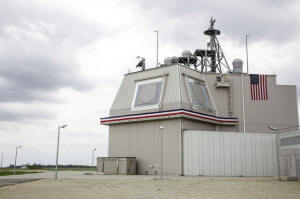|
Exclusive: Japan seeks new U.S. missile
radar as North Korea threat grows - sources
 Send a link to a friend
Send a link to a friend
 [August 30, 2017]
By Tim Kelly and Nobuhiro Kubo [August 30, 2017]
By Tim Kelly and Nobuhiro Kubo
TOKYO (Reuters) - Japan is worried the
United States has so far declined to arm it with a powerful new radar,
arguing the decision makes the U.S. missile defense system it plans to
install much less capable of countering a growing North Korean threat,
three sources said.
Japan wants to have a land-based version of the Aegis ballistic missile
defense (BMD) system operational by 2023 as a new layer of defense to
help counter North Korea's missile advances.
Yet, without the new powerful radar, known as Spy-6, Japan will have to
field the system with existing radar technology that has less range than
a new generation of BMD interceptor missiles, the sources who have
knowledge of the discussion told Reuters.
That could mean that while the interceptor has enough range to strike a
missile lofted high into space, the targeting radar may not be able to
detect the threat until it is much closer.

Japanese officials have witnessed a demonstration of Spy-6 technology,
which boosts the range of BMD radars dozens of times, but efforts to
secure the equipment from their ally have come to naught.
"So far all we have got to do is smell the eel," said one of the
officials, referring to a savory fried eel dish popular in Japan.
The military threat to Japan deepened on Tuesday when Pyongyang fired an
intermediate range ballistic missile (IRBM)over Japan's northern
Hokkaido island. Japanese Prime Minister Shinzo Abe slammed the action
as "reckless" and "unprecedented."
Japan's Defence Ministry and the Pentagon did not immediately respond to
requests for comment.
IRONCLAD
Washington's reluctance to share the radar may make Tokyo feel more
vulnerable to North Korean attack and blunt U.S. efforts to assure its
Japan about its commitment to defend its East Asian ally to as tensions
in the region intensify.
The new U.S. Ambassador to Japan, William Hagerty, dubbed their security
partnership as the "greatest on earth" in his first meeting with Abe on
Aug 18.
The U.S.'s top general, Joint Chiefs Chairman Gen. Joseph Dunford
described that alliance as "ironclad" in talks with the Chief of Staff
of Japan's Self Defence Forces, Admiral Katsutoshi Kawano the same day.
Still, a pledge to let Japan have Spy-6 has not been forthcoming. Japan
has not yet placed an order for Aegis Ashore, but has informally asked
Washington to let it have the new radar technology.
[to top of second column] |

The deckhouse of the Aegis Ashore Missile Defense System (AAMDS) at
Deveselu air base, Romania, May 12, 2016. Inquam Photos/Adel
Al-Haddad/via REUTERS/File Photo

"There is no guarantee that Japan is going to get it," said another
of the sources. The U.S. Navy supports giving Japan the new radar,
the source said, but may be thwarted by reluctance from the Missile
Defence Agency, which is responsible for developing BMD technology.
Officials there are wary to release advanced technology, even to a
close ally, before the United States has fielded the technology. The
United States' first Spy-6 equipped Aegis warship is not slated to
begin operations before 2022, one of the sources said.
Tokyo will need permission to use Spy-6 well ahead of that roll out
date to give the maker, Raytheon Co and Aegis system integrator
Lockheed Martin Corp time to build and test the system.
Any decision to hold back Spy-6 could therefore add significantly to
Japan's already rising bill for missile defense by forcing it to pay
to upgrade or replace Aegis Ashore systems after deployment.
Tokyo plans to build two Aegis Ashore batteries, costing around $700
million each without missiles, the sources said. That would mean its
southwestern Okinawa island chain would likely be protected by one
of Japan's existing BMD warships.
The Aegis system's new SM-3 Block IIA defensive missiles, designed
to hit warheads Pyongyang may try to fire over its missile shield,
can fly more than 2,000 km - about twice the distance of the current
SM-3 missiles.

The interceptor missiles will cost around $30 million each, the
sources added.
(Reporting by Tim Kelly and Nobuhiro Kubo in TOKYO; Additional
reporting by Idrees Ali in WASHINGTON; Editing by Lincoln Feast)
[© 2017 Thomson Reuters. All rights
reserved.]
Copyright 2017 Reuters. All rights reserved. This material may not be published,
broadcast, rewritten or redistributed. |